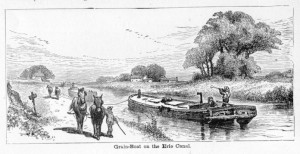
The United States was a growing nation during the nineteenth century. It grew territorially, spreading from sea to shining sea. It also grew industrially, from an agrarian society in the 1800s to the world’s greatest industrial power in the early 1900s. Cities popped up across the Midwest and Northeast. This evolution of the Great Lakes region (New York, Ohio, Michigan, Illinois) was due in a large part to the innovation of the canal. Canals were not completely new but during the early 1800s the canal became a centerpiece of American life in the Great Lakes region. It became an important part of the American, particularly Northern, economy.
No doubt, the greatest canal in the Great Lakes region was the Erie Canal. The Erie Canal stretched for over 360 miles from the city of Albany, NY to the city of Buffalo, NY. This canal linked the Hudson River, and thus the Atlantic, to the Great Lakes, namely Lake Erie. The construction of the canal was begun in 1817. It was not finished completely until 1825. The canal proved to be a decisive part of early American trade and commerce. It was truly foundational in the preeminence of two great American cities: New York and Chicago.
Flatboats were sailed through the canal being pulled by mules on land and guided by seamen on board the boat. These flatboats brought supplies and goods to the Great Lakes region. This canal truly transformed the Great Lakes region and the entire Midwest for that matter. It was the fastest route from the Atlantic to the Great Lakes until trains came along. Although the dawn of the railroad signaled an end to the golden age of the Erie Canal, this canal made a lasting effect on the American map.
The Erie Canal led to the preeminence of two American cities as I have said before. These two were New York City and Chicago. The Erie Canal changed New York City because it was the main route from the Atlantic to the Great Lakes. This led traders and seamen to use the port of New York City more than other Eastern American ports such as Boston and Philadelphia. The canal also led to the growth of the Great Lakes area of New York State, namely Buffalo. The canal also led to the growth of Chicago. The Erie Canal provided a viable, quick, efficient route of transport between the Atlantic and the Great Lakes. This vital connection is what practically built Chicago. Without the canal, Chicago would not have become the trade center that is did. Other cities like Buffalo and Detroit grew as a result of the canal.
